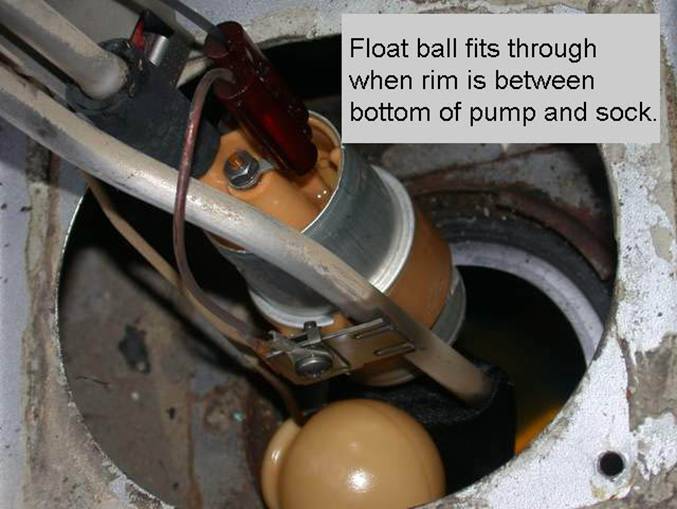|
|
|
I am working on a 1983 242. The intank pump has two connections, power and ground. Both connections have coiled wires around plastic posts connecting to the pump. How important are the coils? They have been destroyed on this pump assembly, and I must eliminate the coils and make direct connections to reuse this pump and sender assembly. I have the pump assembly from a 1995 940 and it is direct connection to the pump, no inductive coils. Of what value are the coils on the 240 intank pump?
In addition, the sending unit works great when testing out of the tank. When in the tank, it shows low, at about the top of the red (reserve) on the guage.
--
john
|
|
-
|
|
|
The coils are there to reduce radio interference from the arcing between the brush and commutator. I doubt you'll experience more interference with them eliminated unless, perhaps, your antenna is on the rear quarter panel and you listen to an AM station.
--
Art Benstein near Baltimore
Occam's Razor: That among competing hypotheses, the one with the fewest assumptions should be selected.
|
|
-
|
|
|
Thanks, Art. A little inductance to smooth out current flow. I haven't listened to a car radio in many years.
I'll be experimenting with the sender assembly today. I don't know if this aftermarket float is hitting the inside of the well in the tank.
--
john
|
|
-
|
|
|
One of the many aftermarket senders I've used had a crack in the float.
In The Tank

--
Art Benstein near Baltimore
Why is the time of day with the slowest traffic called rush hour?
|
|
-
|
|
|
After testing the float assembly laying in the trunk, I installed the float fuel pump assembly. Using dental floss I ran a loop around the float arm and up through the smallest tube in the top of the assembly. I was able to manipulate the float throughout it's travel. Then I dropped one end of thge floss, and removed it by pulling on the other end. The calibration isn't what I expected, but using the car will tell me if I can live with it. If necessary I'll remove the assembly and try bending the float arm.
--
john
|
|
-
|
|
|
John, that is a clever trick with the floss.
I'm left wondering how the gauge readings differ from your expectation. And are you comparing to the way it worked before replacement? I have a general view that the gauges are very conservative on the lower half, in other words, the orange reserve area tends to span several interstate highway exits. Can't say whether that holds true in Nebraska, Saskatchewan, or Wyoming.
The gauge itself is adjustable too. It works by heating bimetal, so temperature is always a factor. Here are some very old notes of mine. Ignore the arrow on the gauge pic, I was just pointing out a typical failure for someone.
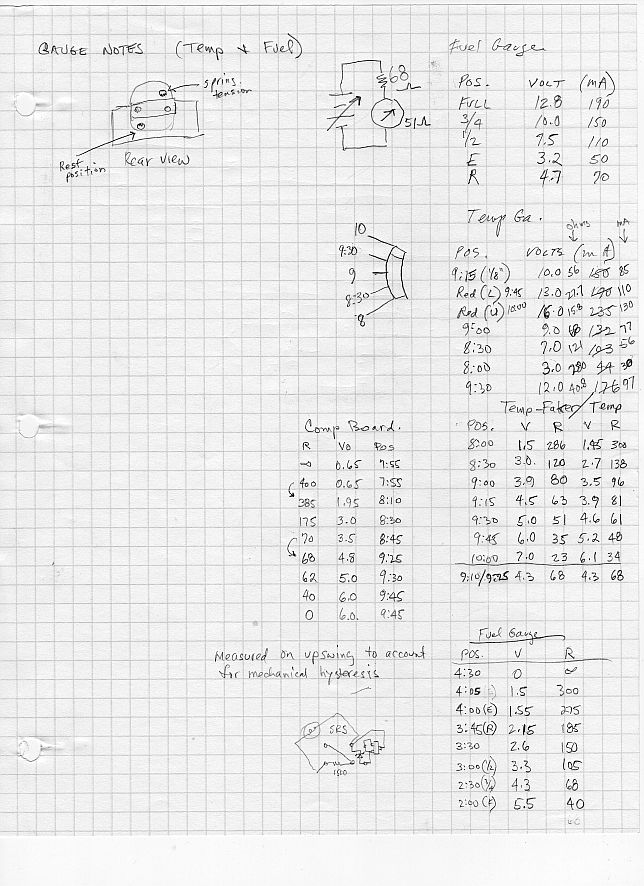
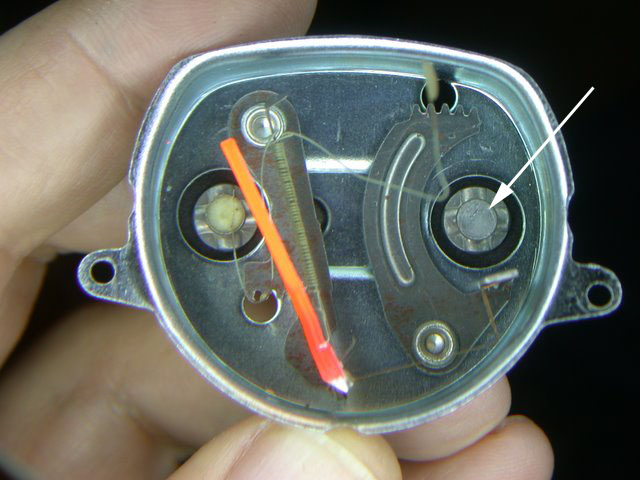
--
Art Benstein near Baltimore
Broken corn chips often resemble Minnesota.
|
|
-
|
|
|
Art, when I bought the car five months ago, the fuel gauge needle was at the top of the red, which warns of a nearly empty tank. I was seventy miles from home, and filled up the car at the first gas station I came to. It took less than three gallons to fill the tank, and the needle didn't move. I knew something was wrong. The in tank fuel pump made noise, but evidently wasn't pumping anything, as the car would quit going up a steep hill.
I bought a new fuel gauge sending unit and in tank pump. When I removed those parts from the tank two weeks ago, I discovered severe corrosion on the sending unit and inside the tank. I replace the tank with a nice used unit, and installed the sending unit with fuel fuel pump. The car runs well, and the gauge indicates full with a tank full of gas. As I drive this car, I'll learn how to interpret the fuel gauge indication to real life.
--
john
|
|
-
|
|
|
Hi Dave,
This is the data I have from 24 2300 miles trips I've taken along the same route in the last 12 years. 12 of the trips were heading west, 12 heading east.
55,200 miles and 168 fueling events.
They were all 3 day trips in either an 84, 90, or 91 245 automatic. The average daily run was 766 miles and 15.3 hours driving time.
I filled up as soon as possible after the gauge was in the red, which was consistently around 300 miles on all 3 cars. It's hard to say exactly.
Average miles between fills....327 miles
Average fuel volume at fill... 11.5 US gallons which gives an
Average mileage of ... 28.4 mpg
That mileage gives these cars a theoretical range of 450 miles on a full 15.8 gallon tank. I haven't tried to prove that, but I have done over 400 a few times when a station I'd planned on was closed. It's a little off putting though, because the needle is almost off the scale entirely.
If I'm in the black zone of the gauge for 327 miles and the car's range is 450, then the black zone accounts for 73% of the gas, leaving 27% for the red zone. That's about a quarter tank, a good time to gas up for the health of the pumps, but a fair ways from empty.
I think this concurs with Art's comments above, although it depends on where you travel. I wouldn't suggest heading north up I95 from Bangor, Maine on a snowy night with a quarter tank while thinking you're good for 2 or 3 exits. That is unless hiking's your thing. In most of the country though, I expect you'd be fine.
Peter
|
|
-
|
|
|
This discussion of how many miles we're good for out of a tank brought to mind the hilarious car dealership episode on Seinfeld where Kramer and the salesman go on a test ride in the car Jerry is buying that quickly turns into a Thelma and Louise adventure to see how far they can go on an empty tank. I couldn't help but look up the script so I've pasted a bit here.
Kramer: Well, it’s a test drive, right? I never drive around here. If I’m gonna recommend this car, I need to see that it’ll handle my daily routine.
Rick (salesman): So where are we going?
Kramer: Just a little place I like to call... you'll see.
...
Kramer: Well, just one more errand and we can head back.
Rick: Actually, it looks like we’re gonna need some gas.
Kramer: Oh? Well, how much gas do you think is in there right now?
Rick: (looking) Well, it’s on "E".
Kramer: You know, uh, oftentimes, Jerry - he lends me his car and I find myself in a situation where the car is almost out of gas. But, for a variety of reasons, I don’t want to be the one responsible for purchasing costly gasoline.
Rick: So, you want to know how far you can drive your friend’s car for free.
...
(Much later in the drive, the needle is now below "E" and Rick is staring at it)
Rick: Is it just the angle I’m looking from?
Kramer: No, Sir. We are down there.
Rick: Oh, this is amazing! Oh, I’ve never felt so alive!
Kramer: Yeah, well, alright. I’m satisfied. We better get some gas.
Rick: What? Well, we can’t stop now.
Kramer: What do you mean?
Rick: We have to keep going - all the way back to the dealership. That was the plan.
Kramer: There was no plan.
Rick: Well, let’s make it the plan! Let’s just.. go for it! Like Thelma and Louise.
Kramer: What, they drove to a dealership?
Rick: No, they drove off a cliff.
(Kramer eyes Rick, frightened)
Kramer: You're one sick momma... I like it!
(Kramer and the salesman look at each other, hold hands, and Kramer steps on the gas pedal as they head off into the sunset, a direct takeoff from a scene in the movie.)
...
(Much later at a gas station buying snacks, Rick is about to give in and reach for the gas pump.)
Kramer: No, man! Not the gas!
Rick: But it needs it, Kramer! It needs it bad!
Kramer: Do you think that this'll make you happy? 'Cause it won’t!
...
Kramer: Listen to me. When that car rolls into that dealership, and that tank is bone dry, I want you to be there with me when everyone says, "Kramer and that other guy, oh, they went further to the left of the slash than anyone ever dreamed!"
Other hilarious scenes in this episode include:
A discussion of dealer charges...
George: (to salesman David Puddy) First they stick you with the undercoating, rust-proofing, dealer prep... Suddenly you're on your back like a turtle.
Jerry: Alright, alright. Alright, that's enough! Let's get back to my deal. That undercoating, that's just a rip-off, isn't it, David?
Puddy: Oh, we don't even know what it is.
On being called a grease monkey...
Jerry: So, Puddy, this is a pretty good move for you, huh? No more "grease monkey".
Puddy: I don’t care for that term.
Jerry: Oh. Sorry, I didn’t know..
Puddy: No, I don’t know too many monkeys who could take apart a fuel injector.
Jerry: I saw one once that could do sign language.
And a final one just for us brickboarders...
George: (to the man in line at the service desk) Yeah right.. I’m gonna get my car repaired at a dealership. Huh! Why don’t I just flush my money down the toilet?
...
(this scene later ends with George's famous Twix bar taste test)
Mechanic: Hey, this Clark bar is good.
George: It’s a Twix! They’re all Twix! It was a setup! A setup, I tell ya! And you’ve robbed it! You’ve all screwed me again! Now, gimme one! Gimme a Twix!
Mechanic: They’re all gone.
George: (yelling out as the camera spins from above) Ttttttwwwwiiiiiixxxxx
--
Dave -still with 940's, prev 740/240/140/120 You'd think I'd have learned by now
|
|
-
|
|
|
Back in my 140 days I went through a period of fuel level sending unit and gauge issues. It didn't at all help that I couldn't always afford to keep it topped up, often running in the red zone. I soon learned to reset the trip gauge every time I filled up and made my wife do likewise. To this day we both maintain that habit and it still occasionally pays off when there are suspect readings or I need a better guess if I can make it to the next town for cheaper gas or should turn back and pay top price.
--
Dave -still with 940's, prev 740/240/140/120 You'd think I'd have learned by now
|
|
-
|
|
|
Dave,
Most of our fuel is purchased and spent locally. I try to keep the tank full; that is not sitting for any length of time with a lot of room for water condensation. We write the mileage and trip numbers on the gas receipt and hit the trip button. Locally I get antsy when I see the trip odo clocking into 3 digits unless we're doing a great deal of running around or it raining.
Got a kick out of "...made my wife do likewise" as it took literally years for mine to adjust to the fact I was happier when she adopted this bit of my OCD behavior with the gas receipts and the trip button.
However the reverse is true when on the long interstate trips. I like to push it over 300 miles. It took me years to adjust to her craning her neck around the center console to look at the gas gauge and understanding her anxiety when it fell below a quarter tank. Her dad set that standard before my time.
--
Art Benstein near Baltimore
From Rock Auto's newsletter:
I used to own a 1972 BMW 2002 sport sedan in tennis ball yellow. It was a great car, but it started stalling out on a random basis, usually when zipping along the freeway. I checked the fuel pump and replaced the fuel filter, but that did not fix it.
I decided to try another approach. The fuel tank, which was mounted under the trunk, offered an unusual service hatch on top so you could replace the in-tank fuel strainer or fuel gauge sending unit. When I removed the trunk floor and cracked open the hatch, I discovered the trouble. In the otherwise perfectly clean tank, a well-preserved leaf was floating around in the gasoline! I realized that when the leaf floated under the flat fuel strainer, and when the suction was great enough, the leaf would be sucked up and caught against the strainer, blocking the uptake of fuel. When the car would die, the leaf would be released and float away, allowing the car to start.
Please do not tell my wonderful wife, but I simply took a pair of salad tongs from her kitchen drawer and plucked the naughty leaf out of the tank. The problem was solved, but I never did figure out how that pesky leaf got in the tank in the first place.
Stan in Oregon
|
|
-
|
|
|
John, I'm curious about your decription here. I'm quite familiar with the 1995 940 pickup assembly. The 1994-1995 fuel tank sending units are designed for the larger and deeper later 73? litre tanks, so not at all compatible with the earlier 740 and 940 tanks and sending units, let alone the earlier 240 units. In these later sending units, there are two induction coiled rods inside the barrel with a float that has a nickel coated contact strip riding between the two rods. This is strictly for the gauge and has no bearing on fuel pump pickup. That contact strip on the later 940 floats is also noted for "finger" wear creating significant issues with sticky gauge readings, most notably suddenly jumping from near full to near empty and the red LED "empty tank" warning lamp falsely illuminating when the tank is actually brim full. Perhaps you could re-explain your issue in light of what I've just said.
--
Dave -still with 940's, prev 740/240/140/120 You'd think I'd have learned by now
|
|
-
|
|
|
Hi Dave,
You're correct about finding a barrel (about a foot long) in 940 fuel tank which acts as a fuel level sending unit, within which contained two long rods (plastic coated) with coiled wires (resistance wires). And there's a cylindrical plate float (with internal contact points) riding between those long rods to connect them electrically thus changing the resistance to affect the fuel gauge.
I think what John refers to in his question is about two small chokes (less than 1 inch long) at the in-tank fuel pump motor electrical connectors. My 1994 940 has it.
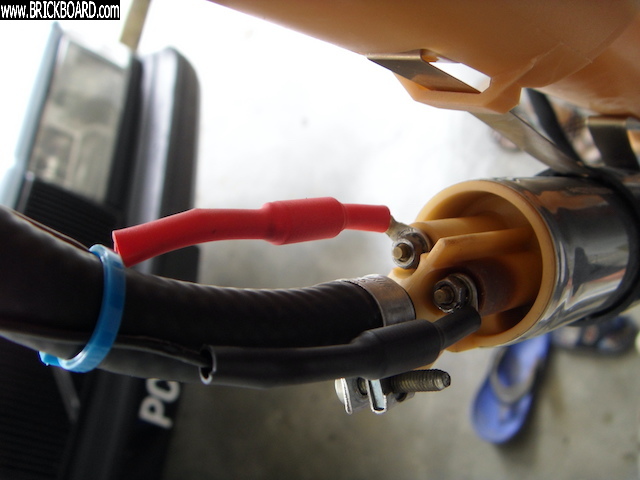
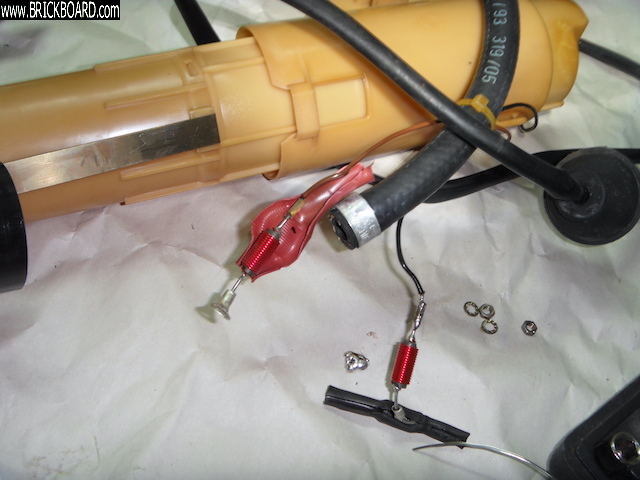
Amarin.
|
|
-
-
|
|
|
In one of your pics, you note the polarity was reversed for the ground connection on the pre-pump causing the pump to run in reverse. For whatever silly reason, the yellow wire was always ground and the black wire was +12V as you will note in wiring diagrams. I learned that lesson the hard way and embarassingly it was on someone else's car. I was showing off my skill on how easy the pre-pumps were to replace. Amazingly, the engine started and idled just fine in the garage, so I took a well deserved bow and departed. Next day I learn the engine was badly stumbling and stalling under acceleration even though it was still driveable. They took it to a shop figuring this was a new and unrelated problem. Took a bit for the shop to figure it out, of course making me look bad in the process, but admitted they'd made that same mistake in the past.
--
Dave -still with 940's, prev 740/240/140/120 You'd think I'd have learned by now
|
|
-
|
|
|
Very interesting, Art. Thanks for explaining that. I'd always kind of wondered why those long terminal contact nipples so now I know what's inside. John should note that the in-tank pump he's looking at on his '95 sending assembly is a full blown main pump and not a wimpy pre-pump. It may be of better design to reduce radio interference such as having a full metal jacket for shielding or less noisy contacts.
Just as an FYI to others here, although this tagged as a 240 post, I'll mention that the 940 NA engines were mostly all Regina (as were a few of the later 740s depending on market). Regina uses an in-tank main pump and no pre-pump. 940 turbos (and the 16-valve NA) were always LH 2.4, which previously used an in-tank pre-pump like the 740 and 240. In 1995, the 940 NA engine became LH 2.4 rather than Regina. Also in 1995, Volvo went with an in-tank main pump for both the NA and turbo, but a different pump than used with Regina (presumably working at a different pressure). The also went with a larger 73? litre fuel tank that required a longer barrel on the pickup assembly. That particular pickup assembly was trouble prone as I noted in my prior reply above. Also in that reply, I said there were inductive coils on the two internal rods in the later units, whereas I meant to say resistive coils.
And speaking of rear quarter panel antennas, even with the signal amplifier that Volvo used with the in-glass antennas found in the later 940 wagons, radio reception is notably weaker than with an external antenna. This signal amplifier is a mystery little black plastic box typically found zip tied to the tank filler neck at the back of the side storage well and gets its 12V power from what would be the antenna motor wire used in sedans. Volvo had previously tried using in-glass antennas in some of the later 140 windshields which provided similarly weaker reception as I well recall with mine. For wagons, given that the roof mounted antennas were perpetually exposed to being snapped off going into garages, I do prefer the in-glass antenna except when trying to get weaker radio signals in fringe reception areas.
--
Dave -still with 940's, prev 740/240/140/120 You'd think I'd have learned by now
|
|
-
|
|
|
Hi Dave,
That's a lot of facts, jack.
While we're on the topic of sending units,
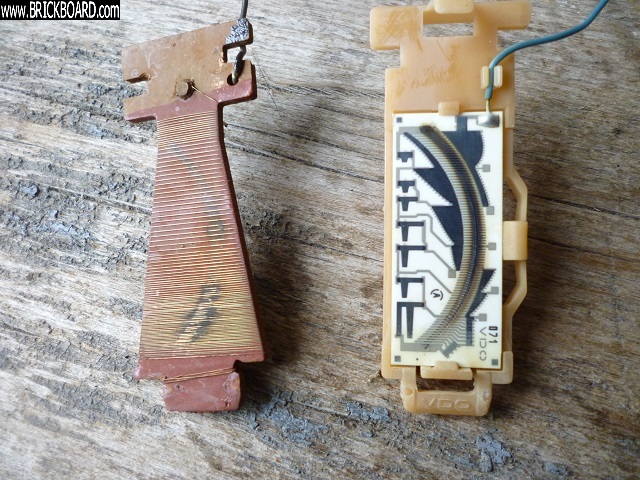
Are these called rheostats ? The one on the left is from a 1980 245, long squirreled away, that I was using to replace the corroded unit in a 90 240 sedan project. It had the rheostat on the right.
I decided to swap the modern stat into the 1980 unit, which was easy and it's working fine, but I can't make head or tails of what the graphics on the newer one are saying.
Would you or someone else be able to shed some light ?
Thanks, Peter
|
|
-
|
|
|
Not Dave, but I can explain the graphics.
The resistive deposit printed on the ceramic base is laser-trimmed to attempt to match the volume-to-level profile of the fuel tank more accurately than the nichrome wire does on the older units.
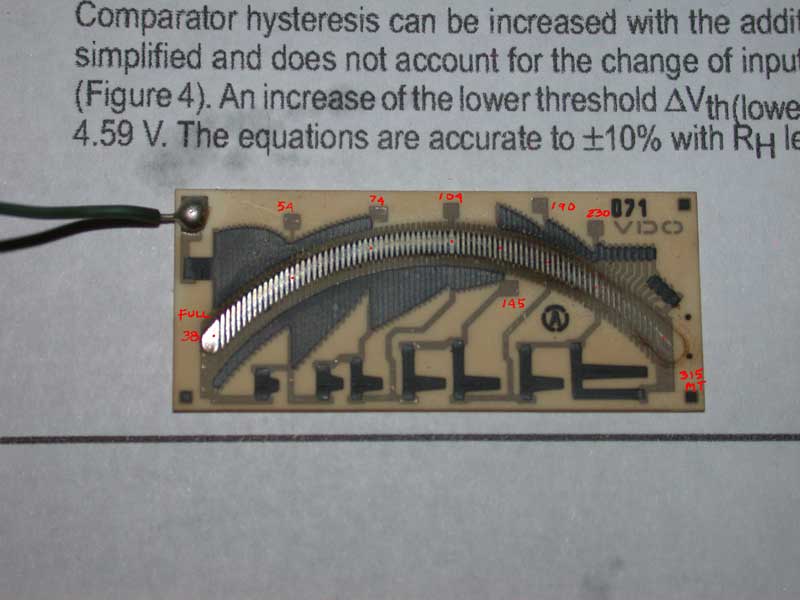
--
Art Benstein near Baltimore
Free advice is sometimes worth what you pay for it.
|
|
|
|
|







